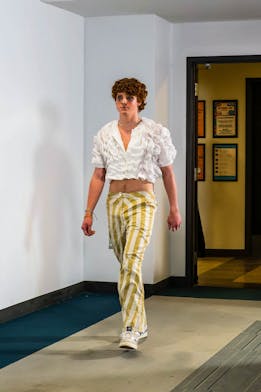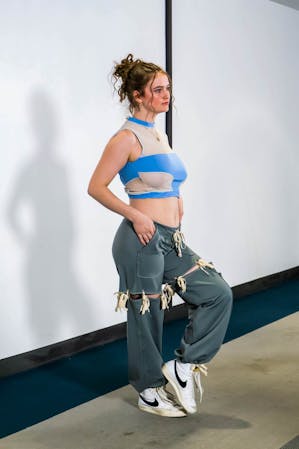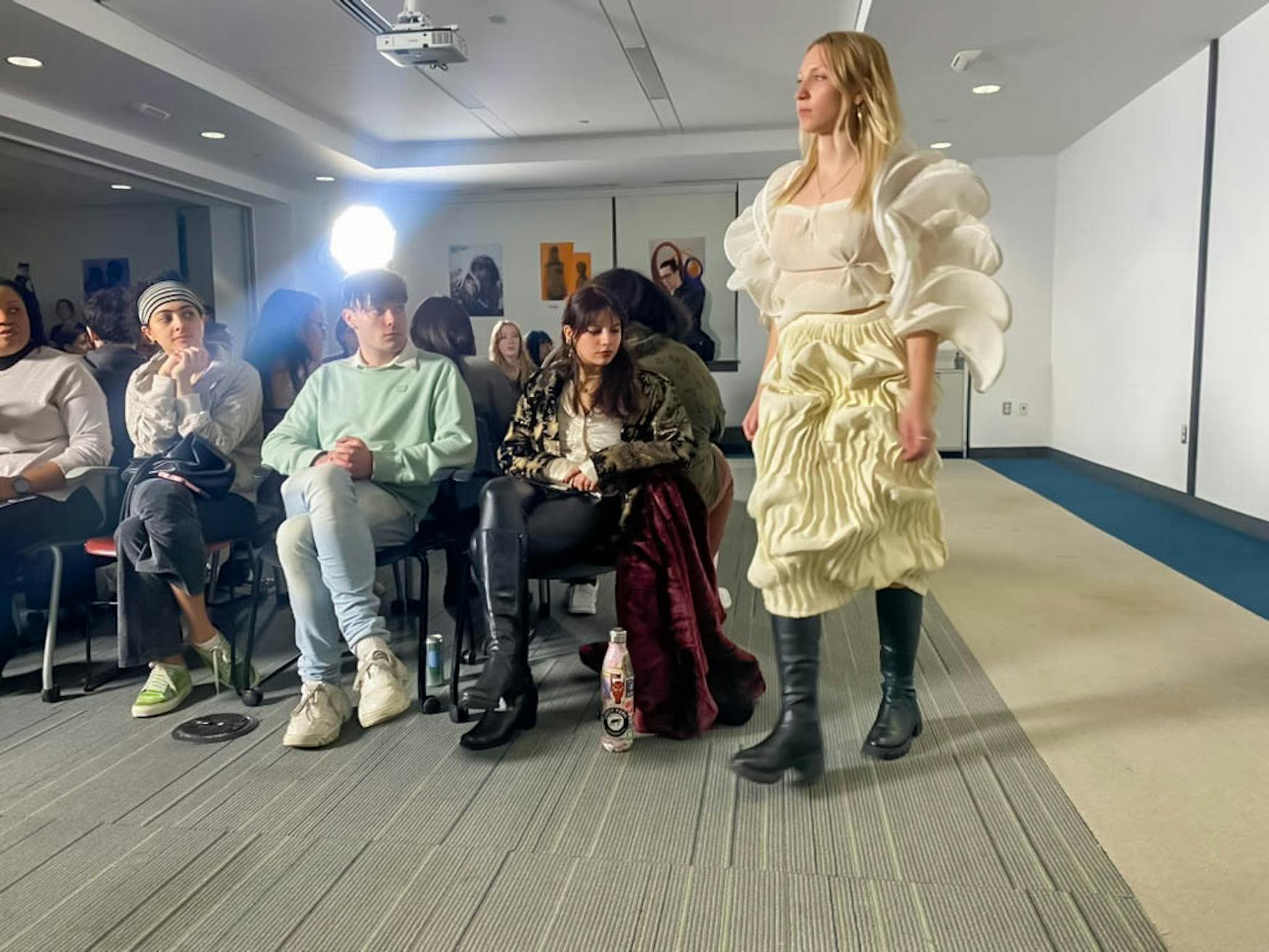Boston’s sustainable student fashion designers
Fashion design students at the Massachusetts College of Art and Design are embracing sustainable practices in their work, from sourcing materials secondhand to zero waste patterning.
Knora’s hands are soft. With nimble fingers she knits from a spool of copper wire, manipulating it as a spider spins a gauzy web. The knit copper forms the bodice of the dress. The skirt and bust are lined with dried oranges. Once a delicate citrus, the produce has been transformed into a collection of unyielding, shell-like discs. They sit layered in a collage that appears impenetrable. A metal made malleable; a raw fruit made hard — these elements interplay in a way that conjures thoughts of vulnerability and consumption for Knora.
“To be a woman is to be consumed,” reads her artist’s statement for the project.
Production and consumption is a process Knora Connollly knows well, having spent the greater part of her life sewing, knitting and eventually selling her garments on a small-business scale before deciding to study fashion design and sustainability at Massachusetts College of Art and Design. She and her peers at MassArt are more than aware of the perils that arise from overproduction and textile waste, which was being generated at 92 million tons per year by 2023. These burgeoning designers have their choice of courses on sustainability as the university offers a minor in the subject. Here, students are taught to leave little to no waste from their work.
As Knora’s dress tells us, history has required women to make themselves objects of consumption. This is what womanhood was and continues to be. “Made palatable, made to please and give herself to others,” she writes. But there is another side to this condition that is often overlooked by the developed world, yet it is sewn into the seams of so many polyester purchases. It is the experience of 75 million garment workers — 80% of whom are women — working up to 16 hours a day, seven days a week.
Of these tens of millions of workers, less than two percent of them make a living wage. According to a 2022 report by Earth.org, brands are able to outsource on a massive scale to unregistered vendors who are exempt from legal requirements that would protect factory workers from monetary exploitation, injury and other physical dangers.
Do any of us really know just how much we’re consuming when we indulge in fast fashion?
At MassArt, fashion students are taught that garment designs are not conceived or executed in a vacuum. The implications of their existence are carefully considered, starting at the conceptual stage all the way to the end of their lifespan. People like Jennifer Varekamp — a MassArt professor, chair of the fashion design department and freelance designer — are vocal proponents of sustainable fashion design in the community.

In the past few years, public consciousness of sustainability and ethical consumption has grown considerably, at least from Varekamp’s observations while teaching various sustainability-focused courses. She’s been running the Sustainable Fashion course for over a decade now, but when it was first introduced she didn’t have many students who knew about the topic. “It’s been a huge turnaround,” she shared, noting a shift towards more engagement across multiple areas of sustainability. According to Varekamp, younger generations are now using social media to place greater emphasis on sustainable practices and demanding transparency from the industry’s major players.
As the conversation around sustainability grows, creative innovations are being implemented on small scales to fight the industry’s consumption problem. Varekamp challenges her students to think outside of the box in making patterns that minimize or eliminate excess materials. One of the first assignments in her Sustainable Fashion course is to design a zero-waste pattern. It follows a movement that has developed over the years in which designers integrate pattern-cutting strategies that produce little to no waste.
Per Varekamp’s explanation, when a garment is mapped out on its chosen fabric, typically 15 to 20 percent of the fabric that is cut out is wasted. “And that generally gets put into a landfill, or worse, incinerated,” she noted. “Every time I am taking a piece of fabric to the trash can, I am very aware of the fact that it’s just getting thrown out,” says student Evie Powers, who studies fashion design and sustainability at MassArt. She took a Creative Fashion course where students were only able to use shapes like squares, rectangles and circles in their designs, because their geometric nature maximized how many could be cut from a bolt of cloth with next to zero waste.
Knora shared a theory about zero waste patterning. “[It] could be so big in fast fashion,” she explained. “It would cut costs because they wouldn’t be losing material.” If zero waste patterns can be more efficient and economical, it begs the question — why aren’t major fashion companies doing it?
“Because it’s not easy,” Varekamp responded, explaining that these designs typically produce more seam lines, which can introduce interesting constructions, but ultimately require more effort. “Yes, in the long run, Knora’s totally right,” she continued. However, streamlining an idea like this on a mass-production level would take time to develop and wouldn’t necessarily be successful in its beginning stages.
At the end of the day, profit still sits at the top of companies’ list of priorities. Regardless of how sustainable a design is, if it lacks aesthetic value, fit or comfort, “no one’s going to buy it,” says Varekamp.
While plenty of designers, scientists, activists and consumers are putting in efforts to reduce their environmental impact, the various inhibitors of textile waste that have been discovered so far still exist in theoretical territory for most companies.

One angle of the sustainable fashion movement that intrigues Evie is the emphasis that is placed on consumer responsibility. From her perspective as a designer, she understands that consumers’ habits are never going to change if the production side of the industry does not change. Take H&M for example, a brand that has implemented a clothing recycling program, but has a reputation for overproducing and refreshing its assortment on a weekly basis. “You can’t expect the consumer to stop buying,” says Evie on brands like H&M, who are constantly releasing new collections. With this in mind, she thinks that it also falls on designers, brands and companies to take action, saying that “they need to be changing as much as the consumers are expected to change their habits.”
On the other hand, Varekamp recognizes the power that consumers hold as a collective force. In her view, the only ways that companies will change is if consumers change their mindsets or if legislation changes everything. “Legislation is the most important piece to holding companies accountable,” she shared. “Consumers can be part of supporting that legislation.”
One piece of legislation that was passed recently is the Climate Corporate Data Accountability Act, set to take effect on Jan 1. 2026. The law requires textile and clothing companies that are conducting business in California to report their greenhouse gas emissions.
Varekamp recommends consumers adopt a more investigative approach in acquiring new clothing. This includes paying attention to certifications that indicate environmentally safe production such as Global Organic Textile Standard, Oeko-Tex or Bluesign. Other organizations like the Fair Wear Foundation or Fairtrade Foundation focus on ethical production, keeping companies accountable for how their workers are treated.
It’s hard to say who is culpable for the tons of waste that end up in landfills or the exploitation of garment workers in this interwoven dance of supply, demand, sales and profit. Is it designers? Fashion company executives? Manufacturers? Consumers?
These young MassArt designers aren’t concerning themselves with these kinds of global corporate machinations. They are instead concerned with what they as individual designers can do in their creative thinking and execution. Questions like “Is [it] transformable? Can it be used in different ways?” are what are on students’ minds, says Varekamp.

On Dec. 6, 2024 Don Magazine, a fashion magazine and club at MassArt, showcased the work of 15 student designers who are producing innovative, sustainable and artful creations. The attendees sat in two back-to-back rows of seats situated in the center of the room while two glaringly white octagonal light fixtures stood on either side.
Duran Duran’s “Girls on Film” queued the show as a percussive camera shutter set the tempo of the event. A bright guitar riff welcomed Mallory Roy and Sera Begay, co-Editor in Chiefs of Don and designers themselves. Following some opening remarks, the models began working their way through the room, one by one, like relay racers passing a baton.
Sera’s look was a modern take of more classical styles. The model wore a ’50s-style black velvet dress reminiscent of Audrey Hepburn peering into Tiffany’s storefront window. The dress bore a satin pink inner lining and was laced up on the sides with black ribbon.
Mallory debuted her first menswear look that night. “I wanted to use a lot of textures,” she said about the piece’s vision. In the style of a cowboy, the look featured a pair of overalls and a matching zippered jacket, made with suede, denim and gingham.

One of Evie’s looks was another menswear ensemble and used all secondhand materials. The top consisted of sheer twill and playfully rouched with elastic; the striped herringbone pants were hand-stitched polyester yarn. With a focus on modularity and an element of interchangeability, her second look was a knitwear project using all stretch material. It featured a pair of pants whose legs were tied onto the shorts with ribbon. “You could change out the legs and mix and match and have fun with it,” she explained.
Knora’s first piece was the zero waste “Amanita Set,” which was her project for the geometric pattern-making assignment and used all deadstock materials. Highly conceptual and innovative, the fungiform-like silhouette was full of movement as the model snaked throughout the room. Evocative of psychedelic mushrooms, both the bubbled skirt and the sleeves of layered roundels appear to expand and contract as though they were alive. Her second look was a plaid dress made with deadstock natural content jacquard knit whose bustier combined knit copper wire and wool yarn. It paired with a hand-knit copper wire bag filled with cloud-like deadstock waste wool.
Once each of the 25 looks were showcased on their own, all of the models walked the runway consecutively, sporting a diverse collection of styles for a breathtaking finale.




Please note All comments are eligible for publication in The Justice.